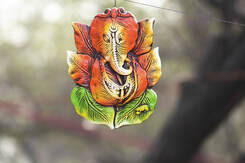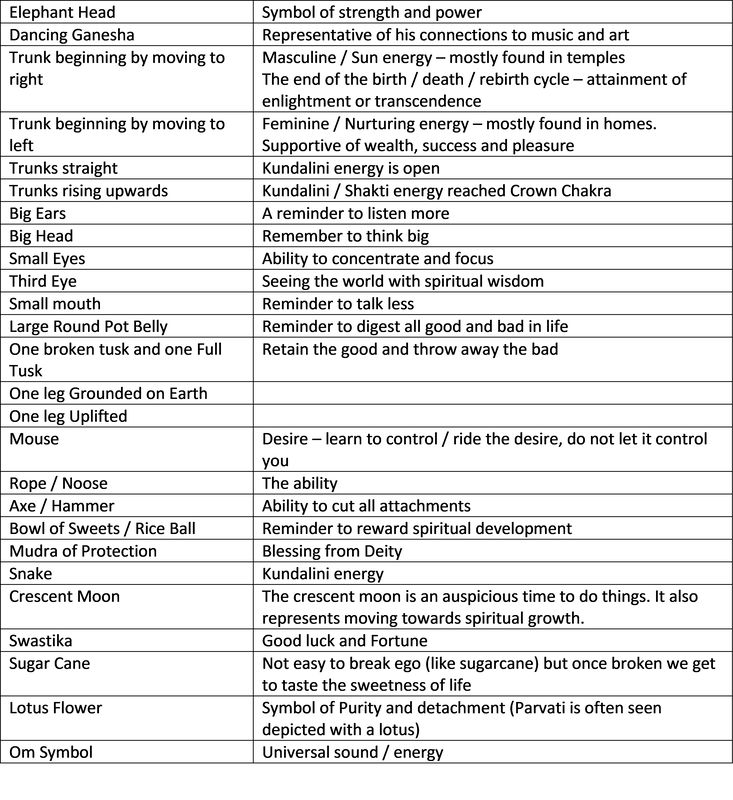
- Hindu Deity or archetype
- Depicted as the head of an elephant and large pot-bellied human body
- He is the remover of obstacles
- The lord of new beginnings
- patron of arts, crafts and sculptures
- lord of astrology, action and god of harvest (particularly for sugarcane growers).
- There are many stories but it is believed Ganesha is the younger son of Parvati and Shiva
What does he symbolize?
In Indian deities like Ganesha are representative of traits or goals that us mere mortals may wish to embody. They (the deities) are often representative of values or potential we wish to create within or for ourselves.
There are 32 forms and importance is given to the posture of Ganesha and the position of his trunk.
He may be seated, standing, dancing and his trunk may be facing straight, left or right. Each has some form of symbolism and meaning for the devotee.
Typically Ganesha is depicted with an elephants head – having a trunk, big ears and a big head. His mouth is small and he has one full tusk and one broken tusk. The broken tusk may be held in his lower right hand.
He is often shown with 4 arms, a big pot belly, one leg grounded on the Earth and the other leg crossed or folded up.
You might note Ganesha has small eyes and a third eye.
He is also often shown with a variety of different animals and other items:
- He is most often seen with a mouse at his feet
- Holding a Lotus in his trunk, a rope in the shape of a noose in one hand, sweet treat (rice ball) in another hand, a hammer or axe in another hand, and often his fourth hand is seen in a mudra of protectiveness
- A snake, crescent moon, sugarcane, swastika and the OM symbol are also often regular features in art work depicting Ganesha.
Ganesh Chaturthi is a ten-day Hindu festival celebrated to honour the elephant-headed God Ganesha's birthday. Ganesh Chaturthi is also known as Vinayaka Chaturthi. The date of the celebrations is based on the cycle of the moon. It falls on the fourth day after the new moon in the Hindu month of Bhadrapada and can begin in August or September.
This year Ganesh Chaturthi celebrations begins on the 2nd September.
Interesting fact about Ganesh Chaturthi is that the sighting of the moon is discouraged. Sighting the moon may result in a curse of dishonor in society and being labelled as one who steals. Of course this curse can be lifted by chanting:
“Simhah Prasenamavadhitsimho Jambavata Hatah।
Sukumaraka Marodistava Hyesha Syamantakah॥“
How can we use him in our practice?
- Call on Ganesha to support your projects and when launching new ideas or endeavours
- Seeking wisdom in decision making
- Ganesha is associated with learning and study and can be used to support you in writing
- He is also an artist and poet so we can call on Ganesha for expression
- Ganesha is a protector of homes and family so statues could be placed in your home or car.
- Ganesha is often called on to help business and is often thought to bring in abundance and prosperity to those business owners that call on his power.
- Ganesha is the remover of obstacles to success.
- Create an altar and place sweet foods under Ganesha statue
- In meditation the Ganesha mudra can be utilized to uplift your spirits, boost your confidence and relieve stress and tension. Include the Ganesha mantra to seal your intention.
- To prepare for Ganesha Mudra you can practice grounding poses, gentle twists and heart opening asana. Pay particular attention to warming up shoulders, arms and chest.
Step 1
Sit comfortably.
Bring your palms to touch in Anjali Mudra. Keep your elbows lifted – avoid dropping them to the waist. This is a shoulder, chest and arm strengthening mudra. It can be beneficial for opening the heart chakra.
Step 2
Then swivel your hands so that your fingertips point toward opposite elbows, with your right palm facing your heart.
Step 3
Bend your fingers and slide your hands across each other until your fingers lock.
Step 4
Repeat on the other side.
Ganesha Mantra
Om gam ganapatayei namaha
REFERENCES
https://chopra.com/articles/ganesha-the-remover-of-obstacles
http://www.thespiritualindian.com/symbolism-of-ganesha-lord-ganesha-symbolism/
https://www.lotussculpture.com/blog/sacred-symbols-lord-ganesh-statue/
http://www.thespiritualindian.com/significance-lord-ganesha-trunk-direction/
https://www.yogamatters.com/blog/ganesh-mudra-meaning-story-elephant-headed-god/
https://www.indiatoday.in/who-is-what-is/story/what-is-ganesh-chaturthi-why-is-it-celebrated-263324-2015-09-16
https://www.yogajournal.com/poses/ganesha-mudra



 RSS Feed
RSS Feed